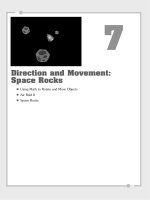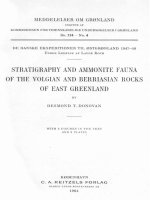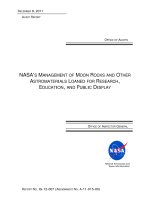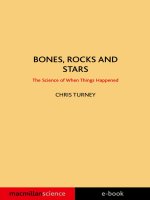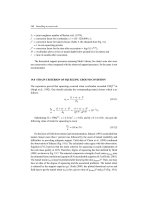Igneous rocks
Bạn đang xem bản rút gọn của tài liệu. Xem và tải ngay bản đầy đủ của tài liệu tại đây (5.38 MB, 35 trang )
Earth Materials: Silicate
Minerals & Igneous Rocks
Today’s Lecture:
Introduction to Rocks
and Minerals
(Continued):
Common rock-forming
“silicate” minerals
(Chapter 5)
Introduction to rocks & the
rock cycle (Prelude A)
Igneous Rocks (Chapter 6)
Question: What minerals would
you expect to be most abundant on Earth?
Percent of elements by WEIGHT
Average composition of the Earth’s crust.
The Common Rock-forming Minerals
Earth’s Crust
Primarily Si & O followed in abundance by
Fe, Mg, Ca, Na, K, etc.
Dark-colored silicates (mantle and oceanic crust)
Olivine (Si, O, Fe, Mg)
Pyroxene (Si, O, Fe, Mg, Ca)
Amphibole (Si, O, Fe, Mg)
Light-colored silicates (crust, esp. continental crust)
Quartz (SiO2) - Hard, transparent
Feldspar (Si, O, Al, K, Na, Ca) - Hard, white, gray, pink
Clay (Mostly come from weathering feldspar)
Calcite (CaCO3, shells) Limestone - Used for cement
Basic Building Block of Silicate Minerals:
The Silicon-Oxygen Tetrahedron
An anion with charge of -4
O
1 silicon (Si) atom
4 oxygen (O) atoms
2-
4+
Si
O
O
2-
O
2-
2-
4SiO4
Silicon tetrahedron has
An overall charge of -4
Silicates: The Common Rock-forming Minerals
Basic Building Block:
The Silicon-Oxygen Tetrahedron
Tetrahedra link up by forming
covalent bonds between oxygen atoms:
Single silicon tetrahedron:
A silicon atom covalentlybonded to four oxygens.
Oxygen atom
Silicon atom
Two tetrahedra can join
by sharing an electron
between adjacent oxygen
atoms
The Common rock-forming minerals
Silicates
Silicon-oxygen tetrahedra can be arranged into:
Single chains: Pyroxene
Double chains: Amphibole
Sheets: Micas
Balancing Charges in Silicates: Role of Metal Cations
Silicate chains and sheets
Unsatisfied
Not electrically neutral!
Iron (Fe)
Magnesium (Mg)
Potassium (K)
Sodium (Na)
Aluminum (Al)
Calcium (Ca)
negative charges
on oxygen atoms
located at the
edges of chains,
or between
sheets, are
neutralized by
coordinating
metallic ions at
those sites.
Ionic Substitution
Ions of similar size (ionic radius) and charge
can substitute for one another in a mineral.
Prelude Chapter: Rocks
Definition of a rock:
A rock is:
1) Comprised of one or more minerals
2) Naturally occurring
There are three types of rocks:
Igneous (formed by cooling from magma)
Sedimentary (formed by the breakdown of other rocks)
Metamorphic (formed when preexisting rocks
are heated under pressure.
Prelude Chapter: Rocks
Rocks and minerals
Some rocks composed entirely of one mineral
limestone (calcite)
Most rocks have more than one kind of mineral
granite
Some rocks contain non-mineral matter
coal (has organic debris)
obsidian (volcanic glassy rock -> not crystalline)
Prelude Chapter: Rocks
rock
Prelude Chapter: Rocks
collection of
one or more
rock
minerals
Prelude Chapter: Rocks
rock
minerals
mineral
Prelude Chapter: Rocks
So far we have:
rock
minerals
mineral
collection of
one or more
minerals
A collection
of one or more
types of atoms
Prelude Chapter: Rocks
Example:
Granite & its
constituent
minerals:
Quartz
Amphibole (hornblende)
Feldspar
The Rock Cycle
Rocks may be classified into three types:
Igneous:
Formed by the crystallization of
molten rock material called magma
Sedimentary:
Formed from pre-existing rocks by
weathering (chemical and physical breakup)
and erosion (transport).
Metamorphic:
Formed by textural and compositional changes
that occur when pre-existing rocks are buried
and subjected to increased temperatures and
pressures.
Rock Cycle (see accompanying slide/MOV):
Connects the three rock groups to each other by process.
The rock cycle is embedded within the hydrological and
the plate cycles discussed previously,
Focus: Interlude A & Chapter 6. Igneous Rocks
Molten rock
In the Earth is called magma.
Magma is buoyant, rises to surface,
& sometimes breaks through as
volcanic eruptions.
When magma reaches the surface it
is called lava.
Igneous Rocks
An igneous rock is formed when magma or
lava cools and solidifies.
Igneous rocks
Why care?
Igneous rocks make up bulk of Earth’s crust.
Earth’s mantle is composed entirely of igneous rock!
Igneous rocks are important economically as
building stones and as host rocks for a variety of
mineral (ore) deposits.
Volcanic activity is a well-known geological hazard,
and the associated igneous rocks hold the secrets
for understanding both the nature of past volcanic
eruptions and the potential for future eruption hazards.
Volcanic Igneous Rocks
Igneous rocks that
form by the eruption
of magma at the
surface are called
volcanic (or
extrusive).
Magma erupted at
the surface is called
lava.
Fragmented
materials are called
pyroclastic and
consist of ash &
cinders.
In igneous rocks, texture is
controlled by the cooling rate
of the magma.
Cooling Rate
Crystal Size
Slow cooling
larger crystals
Fast cooling
small or no crystals
